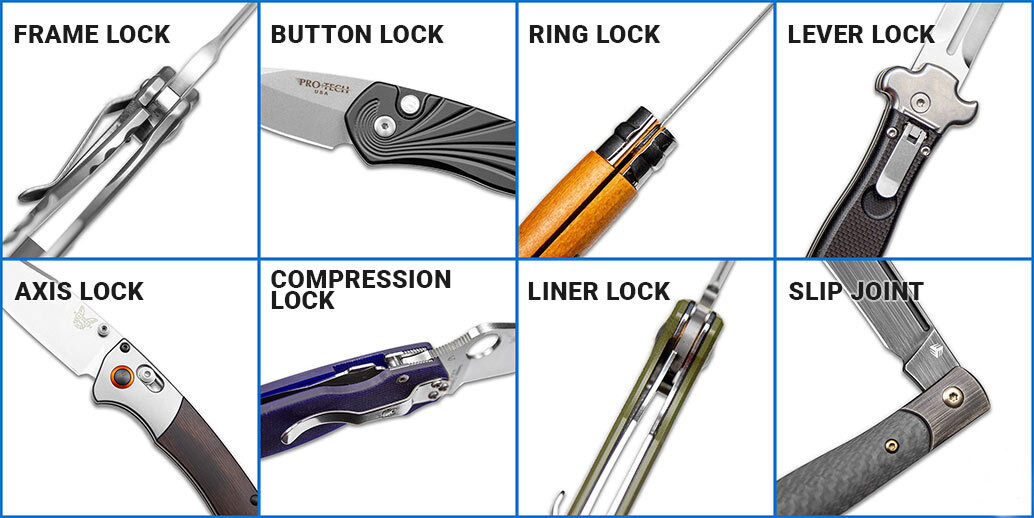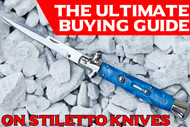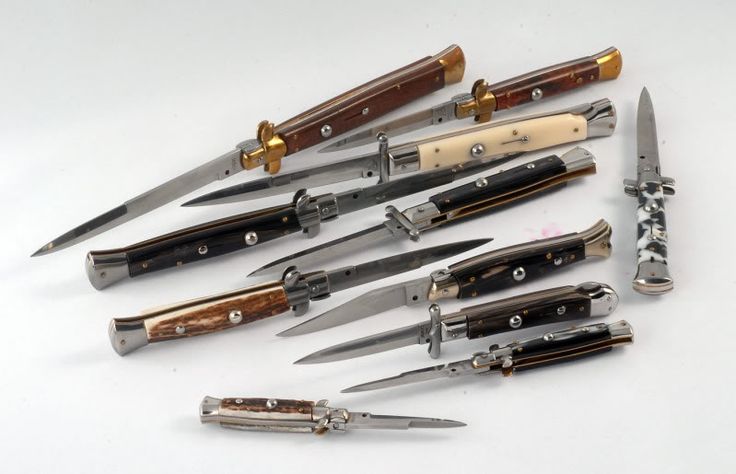The Ultimate Buying Guide on Stiletto Knife
Posted by SwordsSwords on Oct 12th 2023
Welcome to the ultimate stiletto automatic knife buying guide. This buying guide will walk you through the essentials of Italian stiletto knives from the best stiletto knife examples and styles to what to look for and State laws. Consider the following factors when searching for your new snappy-opening companion.
What is a Stiletto?
A stiletto knife is a classic style of straight-bladed pocket knife with a pointed tip. If you're wondering how a stiletto knife works, its simple yet effective design allows for versatile use.
Stiletto knives feature a thin, tapered blade that comes to a fine point, making it well-suited for stabbing or piercing tasks.
How Does a Stiletto Knife Work?
The blade of a stiletto automatic switchblade is usually made of high-carbon steel for strength and holds a sharp edge. When closed, stiletto knives compactly fold into the handle for discreet carry. To open the blade, users depress a spring-loaded button or lever on the handle.
This releases the blade, which is propelled out of the handle rapidly by a strong coil spring mechanism. Once extended, the blade locks securely into place so it won't fold back accidentally during use. This makes stiletto knives a popular choice for self-defense applications due to their fast one-handed deployment and solid blade lockup.
Different Types of Stiletto Knives
- Traditional Stiletto - The classic stiletto design has a very thin, needle-like blade tapering to a sharp point. These usually have no guard or hilt for protection.
- Tanto Stiletto - Similar to a traditional stiletto but with a squared off or triangular blade shape instead of the tapered point. Provides a stronger tip.
- Automatic/Switchblade Stiletto - Features a spring-loaded blade that flicks out rapidly with the push of a button. More convenient than manual opening but also has legal restrictions.
- Folding Stiletto - Has a stiletto-style blade that folds into the handle rather than being a fixed blade. More discreet for carry but blade is shorter.
- Emerson Stiletto - Combines a stiletto blade with Emerson's wave feature, allowing one-handed opening via rearward blade swipe. Faster deployment.
- Trench Stiletto - Designed for self defense, it has a thicker blade than usual stilettos with guard/hilt for protection of the hand. More durable.
- Karambit Stiletto - Incorporates elements of the karambit fighting knife like a curved blade and ring on the handle for different grip.
The blade shape, handle material, and opening mechanism can all vary between different stiletto knife models. Understanding the key types helps buyers choose the right one for their needs.
Stiletto Knife Length
Switchblades are available in many shapes and sizes. You can find some Italian Stilettos that are approximately about 20 inches in length. On the other hand, if you are looking for a compact option, consider buying the 2-3-inch blade. Moreover, if you intend to purchase a tactical blade, a large blade makes for a better option and here we suggest you look for a 7-inch blade.
Blade Steel
A good quality blade steel combines a great edge retention, corrosion resistance and ease of re-sharpening.
- 420HC is a stainless steel offering superlative rust resistance, effective re-sharpening and medium edge retention.
- 154CM is a custom steel with a significant percentage of carbon content. It provides high hardness ratings and enhanced high edge retention.
- S30V is a high vanadium stainless steel offering a higher edge retention.
Handle Materials
You will find most Italian stiletto automatic knives featuring the following handle materials.
- Rubber, Micarta and textured handles offer a better grip in rainy weathers.
- Wood and metal handles provide toughness and aesthetics.
- Composite handles provide better fit, sturdiness, and grip.
Fixed vs Folding
To begin with, buying an automatic stiletto knife, it’s important to decide whether you need a fixed blade or folding blade. A fixed blade is a heavy-duty blade which is easier to maintain and quickly accessed with a sheath. On the other hand, folders are safe and are lock open. Though they are harder to maintain and you need to be very careful with folding mechanism while cleaning yet they are convenient to carry and conceal.
Fixed Blades
Fixed blade knives are a solid piece of metal featuring a tang or full tang construction at the handle end. Tang construction has a spill that fades into the handle while the full-tang construction has handle slabs connected to either side. Though full tang knives are heavier in comparison to the tang, yet they are more durable as well as get the heavy-duty tasks done in no time.
Folding Knives
Folders provide the excellent safety of a closed blade and carry convenience of compact size. These knives have various techniques of opening and closing which are commonly referred by their locking mechanisms.
Switchblade Locking Mechanisms

When it comes to switchblade knives, the locking mechanism is an important factor to consider. This determines how securely the blade stays open during use. There are a few main types of switchblade locks:
- Button lock switchblades use a spring-loaded locking button that must be manually depressed to unlock the blade. This provides very solid lockup that won't fail, making it a popular choice.
- Liner lock switchblades feature a partial liner inside the handle that wedges against the blade tang to lock it open. While reliable, liner locks don't offer quite as positive feel as button locks.
- Frame lock switchblades lock the blade in place by having it wedge against the knife's frame when open. Frame locks provide strong retention but may feel less sturdy than internal locks.
- Back lock switchblades lock the blade against the rear of the handle scale. They require a unique finger flick to unlock. Though unique, back locks can feel slightly less robust than button or liner locks.
Understanding the different switchblade locking mechanisms allows buyers to choose the model with the best lockup feel and security for their needs, whether everyday carry or heavy duty use. A reliable lock gives the user confidence in the deployed blade.
Maintenance and Durability
Proper maintenance is key to maximizing the lifespan and performance of your stiletto knife. These blades are designed to be durable, but still require some TLC to prevent issues down the road.
- Regularly wipe the blade dry after use to prevent water spots and rust. You can also apply a thin coat of lubricant to the pivot points and locking mechanisms every few months. This keeps things moving smoothly.
- Periodically use a sharpening stone or electric sharpener to keep the edge razor sharp.
- Don't submerge automatic knives in water, as this can damage internal components.
- For a deeper clean and tune-up, many reputable brands offer professional servicing.
Taking good care of your stiletto knife is an investment that will be rewarded with many years of reliable, hassle-free use. With some basic upkeep like drying, lubricating and sharpening, your stiletto should remain in top working condition for as long as you own it.
Budget Considerations and Available Options
Quality blades can range significantly in price, from inexpensive manual options under $20, up to high-end automatic models over $200. For casual use, an affordable manual or spring-assisted knife will suffice.
Lucky for you, swordsswords.com offers a wide variety of Italian stiletto knives under different price ranges. Check out our entire collection and pick the best one for you!
Stiletto Knife Laws
Now for a word of caution to close off this buying guide.
Since you have read every word of this stiletto buying guide and will be looking for one of your own, you need to be more careful. Due to their quick blade deployment, the switchblades are illegal and restricted in some parts of the United States. Some of these laws date back to the Hollywood depiction of urban street violence of the 1950s. Make sure to thoroughly read your State Laws on automatic stiletto knives before you go for one.



